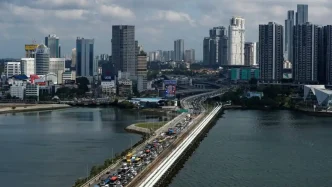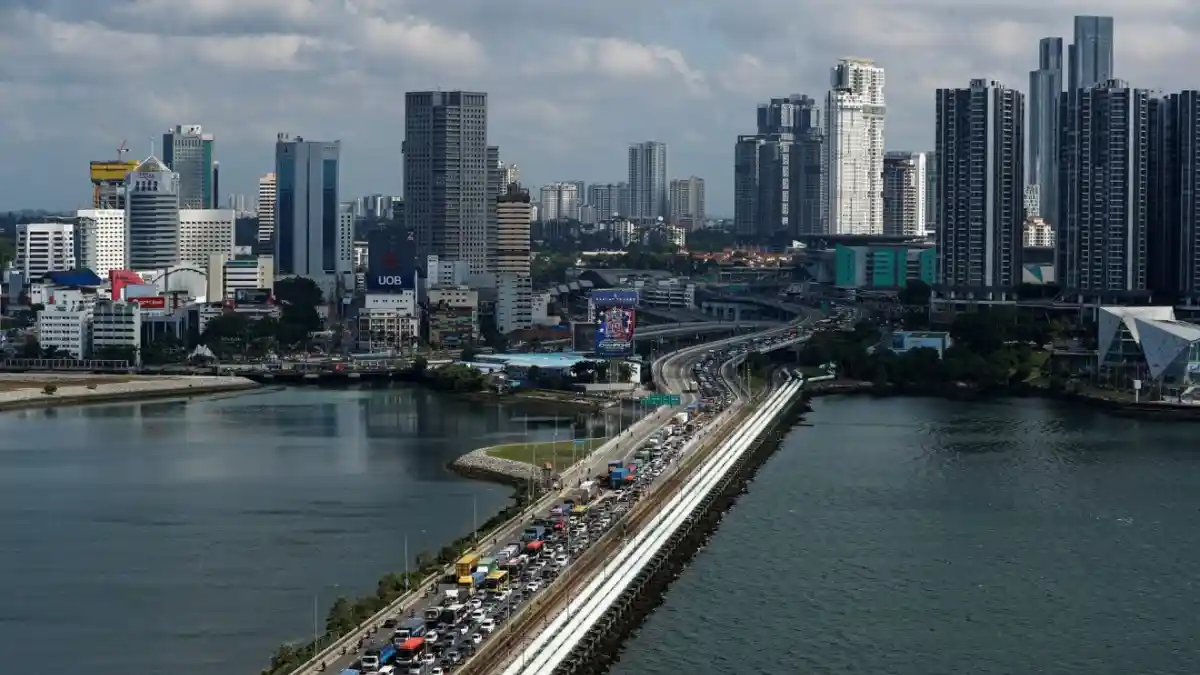Traffic ground to a halt in the early hours of July 1, 2025, as Malaysian authorities rolled out full enforcement of the Vehicle Entry Permit (VEP) system for Singapore-registered vehicles crossing into Johor Bahru via the Causeway. The new rules, which mandate a registered and activated VEP for all foreign-registered private vehicles, have sparked delays, fines, and frustration among motorists caught unprepared at the Bangunan Sultan Iskandar customs, immigration, and quarantine complex.
Midnight Crackdown at the Causeway
As the clock struck midnight on July 1, 55 officers from Malaysia’s Road Transport Department (JPJ) took up positions at the Johor-bound exit road, pulling over vehicles that failed to comply with the VEP requirements. Motorists without a valid permit now face a fine of 300 Malaysian Ringgit (~US$91) before they are allowed to exit the country. Within the first hour of enforcement, 10 Singapore-registered vehicles were issued summonses, according to JPJ officers.
For 19-year-old Safir Farhan, a Singaporean vocational institute student, the enforcement came as a surprise despite his anticipation of stricter rules. Driving his family’s car for a late supper in Johor Bahru with his aunt and sister, he became the first motorist to be fined under the new measures. “I foresaw it (the VEP enforcement) coming, but I wasn’t really expecting it to be this big,”. His journey was delayed by 15 minutes as he settled the fine at a JPJ mobile service van parked roadside.
Safir, who had already registered for the VEP and was awaiting delivery of the required radio frequency identification (RFID) tag, showed an acknowledgment email from JPJ to reporters. “But we’re okay, and they’re (JPJ) just doing their job,” he added, reflecting a resigned acceptance of the situation.
A Long Road to Enforcement
The VEP system, first proposed in 2017, has faced multiple delays in implementation, with plans shelved in 2019 and again in 2020 due to logistical challenges and public backlash. The system requires foreign-registered vehicles entering Malaysia from Singapore to carry an RFID tag, which allows authorities to track vehicles on Malaysian roads and ensure payment of any outstanding traffic fines before departure.
On October 1, 2024, the VEP was officially introduced with a grace period during which non-compliant vehicles received warnings rather than fines. Malaysian Transport Minister Anthony Loke announced in May 2024 that the tags would be mandatory from October, later clarifying on October 4 that enforcement would be delayed, with motorists reminded to apply for the permit upon exiting. By June 4, 2025, Loke emphasized that “ample time” had been provided since the initial announcement for vehicle owners to register, signaling an end to leniency.
The final push came on June 30, when dozens of Singaporean motorists flocked to VEP application and installation centers in both Singapore and Johor Bahru. At the TCSens VEP inquiry center in Danga Bay, Johor Bahru—operated by Malaysia’s ministry-appointed vendor for VEP matters—queues stretched long into the evening. Singaporean restaurant owner Jenny Chia, 53, who had registered for a VEP in November 2024 but struggled to complete the process, arrived at 2 p.m. and was still waiting hours later. “Now… there are around 70 more people in the queue,” she is quoted as saying.
Lorry driver Sasman Isnian, 58, who was further back in the line, expressed uncertainty about waiting due to the late hour. “I’m not sure if I’ll wait for this as it’s getting late,” he said. In response to the surge, TCSens announced that the Danga Bay center would operate on a 24-hour basis starting that day.
Compliance Rates and Corporate Exemptions
As of June 29, 2025, JPJ director-general Aedy Fadly Ramli reported that 248,504 Singapore-registered private vehicles had signed up for the VEP, an increase from 231,018 on June 4. However, 17 percent of these vehicles had yet to activate their RFID tags. Additionally, 3,765 company vehicles had received tags, with 19,690 applications pending in this category.
Recognizing the complexities of corporate registrations, which often involve additional documentation, Transport Minister Loke clarified on June 4 that company vehicles awaiting approval would not face fines but would instead receive reminder notices upon exit. However, company vehicles that had not applied for a VEP must settle fines and complete registration before leaving Malaysia..
For private vehicle owners, no such exemptions apply. “The majority of Singaporeans abide by the rules, but for only a small number of them, we have to ensure they follow Malaysia’s rules,” Aedy told the media on July 1, 2025. He stressed that summonses would be issued to all non-compliant private motorists, even those claiming to enter Johor Bahru to settle VEP matters. “We have given enough time, in fact VEP was announced seven years ago, and during that time we have made many efforts to encourage Singaporeans to register for it. So from July 1, if they come in without a VEP registered and fixed (on their vehicles), we will issue summonses,” he added.
Operational Measures to Ease Congestion
To minimize disruptions at key border points like the Causeway and the Second Link, JPJ has ensured that enforcement operations are conducted away from entry points. Fines can be paid via cashless methods at JPJ counters, mobile counters, or online through the MyEG system, streamlining the process for motorists.
Despite these efforts, the enforcement has not been without hiccups. Singaporean retiree Lee Kim Hock, 70, was among those stopped by JPJ officers on July 1. Expecting delivery of his VEP tag within two days, he took the fine in stride. “My VEP is going to be delivered to me in two days. But it’s okay, I’ll just settle the fine,” he said.
Broader Implications for Cross-Border Travel
The full enforcement of the VEP system marks a significant shift in Malaysia’s approach to managing foreign-registered vehicles, particularly those from Singapore, which account for a substantial volume of daily cross-border traffic. The Causeway, linking Johor Bahru to Singapore, is one of the busiest land borders in the region, with thousands of commuters, tourists, and commercial vehicles passing through daily. The VEP aims to enhance oversight of these vehicles, ensuring compliance with local traffic regulations and facilitating the collection of fines for offenses.
However, the rollout raises questions about accessibility and communication. While Malaysian authorities argue that seven years of notice—coupled with a grace period from October 2024 to June 2025—provided sufficient time for compliance, the last-minute rush at registration centers suggests gaps in awareness or logistical support. For frequent travelers like Safir and Jenny, the system’s requirements add an extra layer of bureaucracy to what was once a seamless journey for leisure or business.
Economically, the fines, though modest at 300 Malaysian Ringgit (~US$91), could accumulate for regular commuters if compliance remains uneven. Singaporean motorists, already navigating currency disparities and cross-border costs, may face additional financial strain. On a broader scale, the enforcement could influence cross-border trade and tourism, sectors vital to both Malaysia and Singapore, especially in Johor Bahru, which thrives on Singaporean visitors seeking affordable dining, shopping, and entertainment.
Balancing Enforcement with Bilateral Ties
The VEP enforcement also underscores the delicate balance between national policy and bilateral relations. Singapore and Malaysia share a complex relationship shaped by economic interdependence and historical ties. While Malaysia has the sovereign right to regulate its borders, the manner of implementation—particularly the abrupt transition to full enforcement—could strain goodwill among Singaporean motorists who view the Causeway as a lifeline for family, work, and recreation.
Public sentiment, as reflected in comments from motorists like Safir and Lee, appears mixed. Many acknowledge the necessity of rules but question the timing and support provided for compliance. Social media platforms like X have seen discussions under hashtags such as #VEPMalaysia, with users sharing tips on registration and venting frustrations over delays as of July 1, 2025. However, no specific posts or quotes from X have been included here, as they require direct verification and citation per editorial standards.
For now, Malaysian authorities remain firm on enforcement, with JPJ director-general Aedy emphasizing a no-excuses policy for private vehicles. Yet, the provision of 24-hour registration centers and cashless payment options signals an intent to mitigate inconvenience. Whether these measures will suffice as enforcement continues remains to be seen.
Looking Ahead: Challenges and Adaptations
As the VEP system beds in, both Malaysian authorities and Singaporean motorists face a period of adjustment. For JPJ, the challenge lies in sustaining enforcement without alienating a key demographic of border-crossers. For motorists, the onus is on navigating a new regulatory landscape, balancing compliance with the practicalities of cross-border life.
The long-term impact of the VEP on traffic flow, bilateral travel, and local economies in Johor Bahru and Singapore is yet to unfold. If registration rates climb and logistical bottlenecks ease, the system could achieve its goal of streamlined oversight. But if delays and fines persist, they may deter casual travel, reshaping a border dynamic integral to the region’s social and economic fabric. As enforcement tightens, the question lingers: will this policy strengthen Malaysia’s regulatory framework, or will it test the patience of its closest neighbors?
















